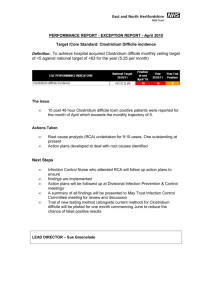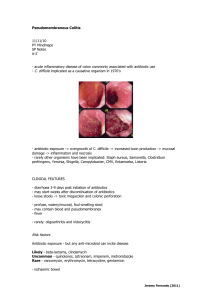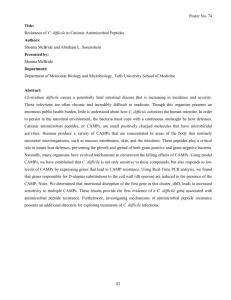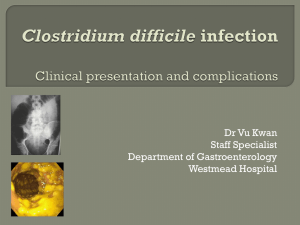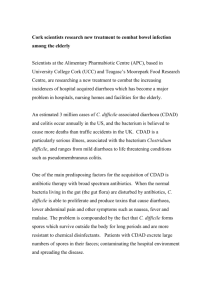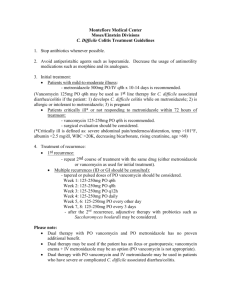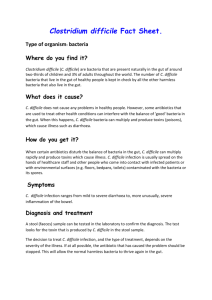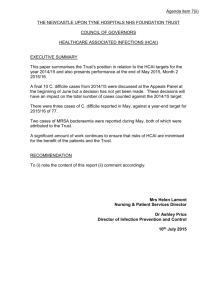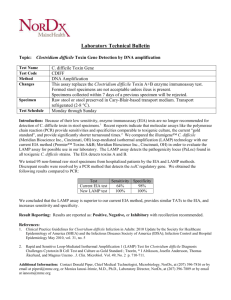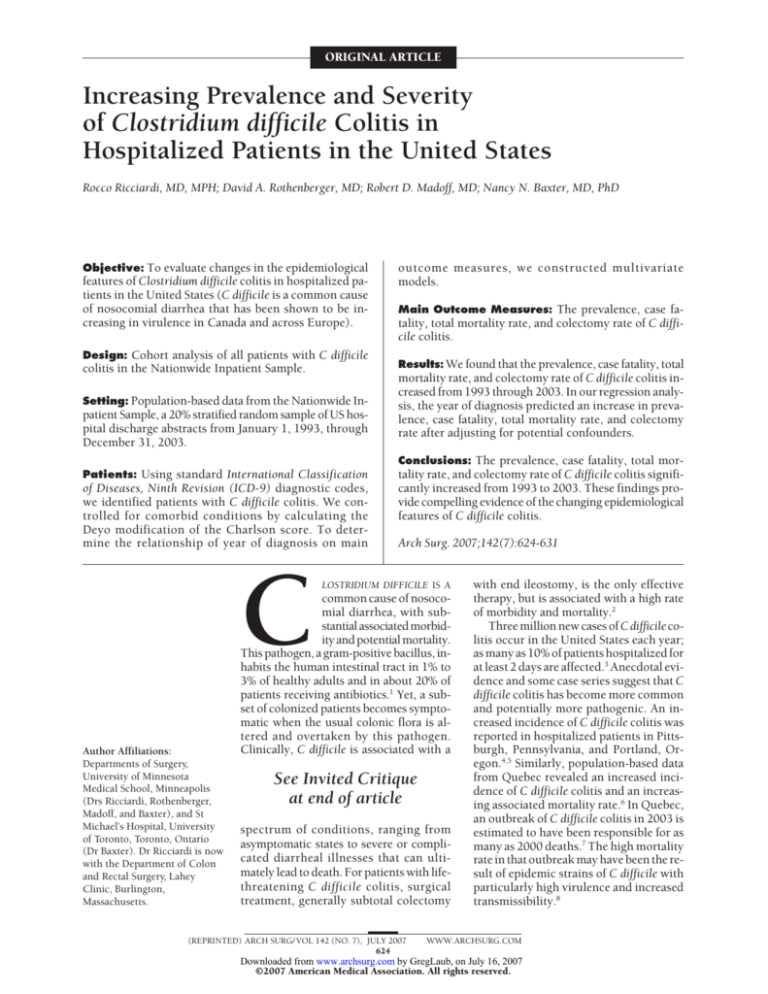
ORIGINAL ARTICLE
Increasing Prevalence and Severity
of Clostridium difficile Colitis in
Hospitalized Patients in the United States
Rocco Ricciardi, MD, MPH; David A. Rothenberger, MD; Robert D. Madoff, MD; Nancy N. Baxter, MD, PhD
Objective: To evaluate changes in the epidemiological
features of Clostridium difficile colitis in hospitalized patients in the United States (C difficile is a common cause
of nosocomial diarrhea that has been shown to be increasing in virulence in Canada and across Europe).
Design: Cohort analysis of all patients with C difficile
colitis in the Nationwide Inpatient Sample.
Setting: Population-based data from the Nationwide Inpatient Sample, a 20% stratified random sample of US hospital discharge abstracts from January 1, 1993, through
December 31, 2003.
outcome measures, we constructed multivariate
models.
Main Outcome Measures: The prevalence, case fatality, total mortality rate, and colectomy rate of C difficile colitis.
Results: We found that the prevalence, case fatality, total
mortality rate, and colectomy rate of C difficile colitis increased from 1993 through 2003. In our regression analysis, the year of diagnosis predicted an increase in prevalence, case fatality, total mortality rate, and colectomy
rate after adjusting for potential confounders.
Conclusions: The prevalence, case fatality, total mor-
Patients: Using standard International Classification
of Diseases, Ninth Revision (ICD-9) diagnostic codes,
we identified patients with C difficile colitis. We controlled for comorbid conditions by calculating the
Deyo modification of the Charlson score. To determine the relationship of year of diagnosis on main
C
Author Affiliations:
Departments of Surgery,
University of Minnesota
Medical School, Minneapolis
(Drs Ricciardi, Rothenberger,
Madoff, and Baxter), and St
Michael’s Hospital, University
of Toronto, Toronto, Ontario
(Dr Baxter). Dr Ricciardi is now
with the Department of Colon
and Rectal Surgery, Lahey
Clinic, Burlington,
Massachusetts.
tality rate, and colectomy rate of C difficile colitis significantly increased from 1993 to 2003. These findings provide compelling evidence of the changing epidemiological
features of C difficile colitis.
Arch Surg. 2007;142(7):624-631
LOSTRIDIUM DIFFICILE IS A
common cause of nosocomial diarrhea, with substantial associated morbidity and potential mortality.
This pathogen, a gram-positive bacillus, inhabits the human intestinal tract in 1% to
3% of healthy adults and in about 20% of
patients receiving antibiotics.1 Yet, a subset of colonized patients becomes symptomatic when the usual colonic flora is altered and overtaken by this pathogen.
Clinically, C difficile is associated with a
See Invited Critique
at end of article
spectrum of conditions, ranging from
asymptomatic states to severe or complicated diarrheal illnesses that can ultimately lead to death. For patients with lifethreatening C difficile colitis, surgical
treatment, generally subtotal colectomy
(REPRINTED) ARCH SURG/ VOL 142 (NO. 7), JULY 2007
624
with end ileostomy, is the only effective
therapy, but is associated with a high rate
of morbidity and mortality.2
Three million new cases of C difficile colitis occur in the United States each year;
as many as 10% of patients hospitalized for
at least 2 days are affected.3 Anecdotal evidence and some case series suggest that C
difficile colitis has become more common
and potentially more pathogenic. An increased incidence of C difficile colitis was
reported in hospitalized patients in Pittsburgh, Pennsylvania, and Portland, Oregon.4,5 Similarly, population-based data
from Quebec revealed an increased incidence of C difficile colitis and an increasing associated mortality rate.6 In Quebec,
an outbreak of C difficile colitis in 2003 is
estimated to have been responsible for as
many as 2000 deaths.7 The high mortality
rate in that outbreak may have been the result of epidemic strains of C difficile with
particularly high virulence and increased
transmissibility.8
WWW.ARCHSURG.COM
Downloaded from www.archsurg.com by GregLaub, on July 16, 2007
©2007 American Medical Association. All rights reserved.
Given the potential changes in the epidemiological and
biological activity of this frequent nosocomial disease,
it is essential that patterns of this disease are evaluated.
However, population-based data in the United States are
lacking. We, therefore, designed this study, using population-based data, to determine the prevalence and severity (as measured by the mortality rate and the colectomy rate) of C difficile colitis in hospitalized patients in
the United States during the past decade.
METHODS
DATA SOURCES
We obtained discharge data from the Nationwide Inpatient
Sample (NIS) for January 1, 1993, through December 31, 2003,
via the Healthcare Cost and Utilization Project of the Agency
for Healthcare Research and Quality. The NIS — the largest
source of all-payer hospital discharge information in the United
States—is a unique and powerful tool. It includes data from about
7 million hospital stays per year in 1000 hospitals located in
35 states; thus, it approximates a 20% stratified sample of US
community hospitals. It provides information on patient demographics, socioeconomic factors, admission profiles, hospital profiles, state codes, discharge diagnoses, procedure codes,
total charges, and vital status at hospital discharge. Along with
other hospital discharge databases, the NIS has been used extensively in the past to review trends in surgical care and outcomes,9 volume outcome relationships,10 and disparities in care.11
A data use agreement is held by the Agency for Healthcare Research and Quality; for our study, all study protocols were considered exempt by the University of Minnesota institutional review board.
PATIENTS
We used diagnostic codes from the International Classification
of Diseases, Ninth Revision (ICD-9) to identify all patients who
were discharged with a diagnosis of C difficile colitis (ICD-9 code
8.45). The diagnostic code for C difficile colitis was first introduced in October 1992, so we excluded data from before 1993.
We evaluated 2 groups of patients with C difficile colitis: (1)
those with a principal diagnosis of C difficile colitis (a group of
patients admitted primarily for C difficile colitis) and (2) those
with a principal or secondary diagnosis of C difficile colitis (a
group for whom C difficile colitis contributed to the hospital
stay but may not have been the primary reason for admission). Patients with a secondary diagnosis of C difficile colitis
may have had multiple other significant conditions contributing to morbidity or mortality. In an attempt to ascertain the
effect of C difficile colitis on mortality, without the effect of other
more potentially serious conditions that are associated with high
mortality, we performed analyses for all outcome measures in
patients with C difficile colitis as a principal diagnosis and in
patients with any diagnosis of C difficile colitis.
We determined the prevalence of disease by recording all
ICD-9 codes for C difficile colitis as a principal or secondary
diagnosis and standardizing with a denominator that included
the total discharges for that year of diagnosis. Thus, the prevalence was described in a population of 100 000 discharged patients and presented as the C difficile discharge rate. This represents the frequency of hospitalization for C difficile colitis
(principal diagnosis) and the frequency of C difficile colitis influencing hospital stay (any diagnosis) in the United States.
We recorded in-hospital deaths for all patients with a diagnosis of C difficile colitis. We calculated case fatality (as a pro-
portionate variable) by dividing the number of deaths in patients with C difficile colitis by the total number of patients with
the disease. To ascertain the burden of C difficile colitis on mortality, we also calculated the total mortality rate (described in
a population of 100 000 discharged patients) by dividing the
number of deaths of patients with C difficile colitis by the total
number of patient discharges. We determined case fatality and
the total mortality rate for patients with a principal diagnosis
of C difficile colitis and, separately, for patients with any diagnosis of C difficile colitis.
We used standard ICD-9 codes to select patients with a diagnosis of C difficile colitis who underwent subtotal colectomy (ICD-9 code 45.8). We excluded patients who underwent segmental colectomy, because the surgical standard of care
for complicated C difficile colitis is subtotal colectomy with end
ileostomy.12 In addition, we excluded patients with a diagnosis of diverticulitis, diverticular hemorrhage, and colon cancers. We determined the colectomy rate for patients with a principal diagnosis of C difficile colitis and, separately, for patients
with any diagnosis of C difficile colitis.
Hospital stay was defined as the difference in days between
the admission and discharge dates. Length of stay was coded
as 0 for patients discharged during the day of admission.
Because immediate care stays have been declining and severity
indexes for hospitalized patients have been increasing, we
adjusted for comorbidity using the Deyo modification of the
Charlson comorbidity index.13 Briefly, we ascertained the
presence of 17 comorbid conditions and then weighted them
according to the original report by Charlson et al.14 An elevated
Charlson comorbidity index has been shown to correlate with
mortality.14
We compared demographic variables over 3 periods ( January 1, 1993–December 31, 1996, January 1, 1997–December
31, 2000, and January 1, 2001–December 31, 2003) using the
2 test for categorical variables and the t test for continuous
variables. For each of the 11 years (1993-2003), we calculated
the prevalence, case fatality, total mortality rate, and colectomy rate for patients with a principal diagnosis of C difficile
colitis and, separately, for those with any diagnosis of C difficile colitis. Using the Cochran-Armitage trend test on 1 df, we
determined whether rates changed over time. To control for
potential confounders, we constructed a logistic regression model
to evaluate the relationship between the year of diagnosis (continuous variable) and the prevalence of C difficile colitis, case
fatality, and colectomy rate; we adjusted for age (continuous
variable), sex, race (white, black, Hispanic, other, or missing),
payer status (Medicare, Medicaid, private payer, or other), and
Deyo comorbidity score (continuous variable). Because the NIS
removes race status for about 20% of all patients, we performed the regression twice (once with missing race as a separate variable and once after excluding all patients with missing race).
All statistical analyses were performed using SAS statistical
software, version 9.13 (SAS Institute Inc, Cary, North Carolina). All tests of statistical significance were 2-sided; P⬍.05
was considered statistically significant. Because the NIS is a stratified probability sample of US community hospitals, we adjusted our calculations for survey sampling characteristics (probability weights and stratification).
RESULTS
The NIS contains 78091119 discharge abstracts over 11
years. During this period, 299 453 patients were discharged with a principal or secondary diagnosis of C difficile colitis. The prevalence of disease in the 11-year study
(REPRINTED) ARCH SURG/ VOL 142 (NO. 7), JULY 2007
625
WWW.ARCHSURG.COM
Downloaded from www.archsurg.com by GregLaub, on July 16, 2007
©2007 American Medical Association. All rights reserved.
period was 383 cases per 100 000 discharged patients.
The rate of C difficile colitis discharges increased from
261 cases per 100 000 discharged patients in 1993 to 546
cases per 100 000 discharged patients in 2003 (Figure 1)
(P⬍.001), a 109% increase. Of all patients with a C difficile colitis diagnosis, 69 373 (23.2%) had a principal diagnosis of C difficile colitis. Patients with a principal diagnosis of C difficile colitis had fewer other secondary
diagnoses and a significantly lower Deyo comorbidity
score (mean ± SEM, 1.23 ± 0.004) compared with patients with any diagnosis of C difficile colitis (mean±SEM,
1.82±0.007) (P ⬍.001). The rate of principal diagnosis
of C difficile colitis during the 11-year study period was
88.8 cases per 100 000 discharged patients. The principal diagnosis of C difficile colitis increased from 71.4 cases
per 100 000 discharges in 1993 to 127.0 cases per 100 000
discharges in 2003 (P ⬍.001), a 77.8% increase.
600
Clostridium difficile Diagnoses
per 100 000 Discharges
500
400
300
200
100
0
1993
1995
1997
1999
2001
2003
Year
Figure 1. Prevalence of Clostridium difficile colitis presented as the hospital
discharge rate for patients with either a principal or a secondary diagnosis of
C difficile colitis.
Proportionately, more patients with C difficile colitis
were women than men (Table 1), although this difference decreased over time (59.80% of cases of C difficile
colitis in women during the earlier period [January 1,
1993–December 31, 1996] vs 58.90% of cases in the later
period [January 1, 2001–December 31, 2003]). During
the 11-year study period, the mean±SEM age increased
from 65.60±0.09 years in the earlier period (January 1,
1993–December 31, 1996) to 67.60±0.06 years in the later
period (January 1, 2001–December 31, 2003). Payer data
revealed that many patients used Medicare insurance; this
proportion increased from 66.10% in the earlier period
to 67.70% in the later period. The mean±SEM Deyo comorbidity score was 1.82 ± 0.004; it increased from
1.75 ± 0.009 in the earlier period to 1.88 ± 0.007 in the
middle period (January 1, 1997–December 31, 2000), and
then declined to 1.81±0.006 in the later period. In addition, the mean ± SEM length of stay was 14.10 ± 0.04
days; it decreased from 15.90±0.09 days in the earlier
period to 13.50±0.04 days in the later period (Table 1).
Abdominal colectomy was performed in 0.27% of
patients with any diagnosis of C difficile colitis (ie, 2.7
colectomies per 1000 patients hospitalized with either a
principal or a secondary diagnosis of C difficile colitis).
The colectomy rate increased from 1.2 colectomies per
1000 patients in 1993 to 3.4 colectomies per 1000 patients in 2003 (Table 2). In the group of patients with
a principal diagnosis of C difficile colitis, the colectomy
rate averaged 0.41% (ie, 4.1 cases per 1000 patients
with C difficile colitis); it ranged from 1.8 cases per
1000 patients in 1993 to 6.4 cases per 1000 patients in
2003 (P ⬍.001).
Of the 299 453 patients hospitalized with a principal
or secondary diagnosis of C difficile colitis, 26 246 (8.76%)
died. The case fatality increased from 7.84% in 1993 to
9.26% in 2003 (P⬍.001) (Figure 2). Of the patients with
Table 1. Patient Characteristicsa
Characteristic
b
Age, y
Sex
Male
Female
Race
White
Black
Hispanic
Other
Missing
Payer
Medicare
Medicaid
Private
Self or other
Length of stay, db
Deyo scoreb
No. of Patients
Aggregate
Earlier Period
( January 1, 1993–
December 31, 1996)
Middle Period
( January 1, 1997–
December 31, 2000)
Later Period
( January 1, 2001–
December 31, 2003)
299 378
299 427
67.00 ± 0.04
65.60 ± 0.09
66.90 ± 0.07
67.60 ± 0.06
40.90
59.10
40.20
59.80
40.90
59.10
41.10
58.90
64.10
8.20
4.30
2.40
21.10
70.90
8.10
3.50
1.90
15.60
67.20
8.20
3.80
2.20
18.60
59.10
8.20
4.90
2.70
25.10
67.00
7.70
21.70
3.70
14.10 ± 0.04
1.82 ± 0.004
66.10
8.00
21.70
4.20
15.90 ± 0.09
1.75 ± 0.009
66.40
7.60
22.40
3.60
14.10 ± 0.07
1.88 ± 0.007
67.70
7.60
21.30
3.50
13.50 ± 0.04
1.81 ± 0.006
299 453
299 406
299 327
299 453
a
Data are given as percentage of each group unless otherwise indicated. Percentages may not total 100 because of rounding. Missing data were as follows: age,
75 patients (0.03%); sex, 26 patients (0.009%); race, 63 095 patients (21.07%); payer, 47 patients (0.02%); length of stay, 126 patients (0.04%); and Deyo score,
0 patients. P⬍.001 for all comparisons.
b
Data are given as mean ± SEM.
(REPRINTED) ARCH SURG/ VOL 142 (NO. 7), JULY 2007
626
WWW.ARCHSURG.COM
Downloaded from www.archsurg.com by GregLaub, on July 16, 2007
©2007 American Medical Association. All rights reserved.
Table 2. Case Fatality and Colectomy Rate
for Clostridium difficile Colitis
10.0
9.5
Variable
Year
1993
1994
1995
1996
1997
1998
1999
2000
2001
2002
2003
Age, y
⬍10
ⱕ10 to ⬍ 20
ⱕ20 to ⬍ 30
ⱕ30 to ⬍ 40
ⱕ40 to ⬍ 50
ⱕ50 to ⬍ 60
ⱕ60 to ⬍ 70
ⱕ70 to ⬍ 80
ⱕ80 to ⬍ 90
ⱖ90
Sex
Male
Female
Race
White
Black
Hispanic
Other
Missing
Payer
Medicare
Medicaid
Private
Self or other
Comorbidity,
No. of diagnoses
0
1
2-4
ⱖ5
Rate per
100 Cases
7.8
8.0
8.0
7.8
8.6
9.1
9.2
9.2
8.8
9.5
9.3
1.4
1.6
2.9
4.0
4.8
6.2
8.1
9.8
11.6
14.0
9.8
8.1
9.2
9.6
8.8
10.7
7.2
10.3
7.1
5.3
5.8
4.9
9.4
10.7
13.8
P Value
⬍.001
Colectomy Data
Rate per
1000 Cases
1.2
1.6
2.1
2.3
1.8
1.8
2.8
2.4
2.9
3.3
3.4
9.0
Mortality Rate
Case Fatality Data
P Value
8.5
8.0
7.5
7.0
6.5
⬍.001
6.0
1993 1994 1995 1996 1997 1998 1999 2000 2001 2002 2003
Year
Figure 2. Case fatality for patients with either a principal or a secondary
diagnosis of Clostridium difficile colitis.
⬍.001
0.4
2.4
2.6
3.3
2.3
3.2
3.7
2.8
1.7
0.9
⬍.001
⬍.001
2.7
2.3
.05
⬍.001
2.5
1.7
2.1
2.8
2.7
.08
⬍.001
2.4
2.1
2.8
2.7
.30
⬍.001
3.1
2.6
2.1
1.5
⬍.001
a principal diagnosis of C difficile colitis, 2377 died (ie,
case fatality of 3.43%; range, 3.26% in 1993 to 3.85% in
2003) (P⬍ .001).
The total mortality rate for the 11-year study period
in patients with C difficile colitis was 33.6 deaths per
100 000 discharged patients. The total mortality rate increased from 20.3 deaths per 100 000 discharges in 1993
to 50.2 deaths per 100 000 discharges in 2003 (Table 3),
a 147% increase. Of the patients with a principal diagnosis of C difficile colitis, the total mortality rate averaged 3.04 deaths per 100 000 discharged patients; it ranged
from 2.32 deaths per 100 000 discharged patients in 1993
to 4.26 deaths per 100 000 discharged patients in 2003
(P⬍.001), an 83.6% increase.
We evaluated the influence of age, sex, race, payer status, and Deyo comorbidity score on prevalence of C difficile colitis, case fatality, total mortality rate, and colectomy rate (Table 2 and Table 3). Although the prevalence
and the total mortality rate increased with the patients’ increasing age, the colectomy rate declined at the higher extreme of age (ie, ⱖ70 years). Although proportionally more
patients with C difficile colitis were women, men had a
higher case fatality and a higher colectomy rate. In addition, patients with private insurance had a lower overall
rate of C difficile colitis, but a relatively high colectomy rate.
As the number of comorbidities increased, so did the prevalence, case fatality, and total mortality rate; however, the
colectomy rate declined (Table 2 and Table 3).
In our multivariate analysis, the year of diagnosis remained a strong predictor of the prevalence of C difficile
colitis, case fatality, total mortality rate, and colectomy rate
after we controlled for potential confounders, including age,
sex, race, payer status, and Deyo comorbidity score
(Table 4). After adjusting for covariates, we found that
the diagnosis of C difficile colitis was significantly more likely
with increasing calendar year (odds ratio [OR], 1.05; 95%
confidence interval [CI], 1.05-1.05; P⬍.001). Also, patients with C difficile colitis were more likely to die with
increasing calendar year, and were more likely to undergo
colectomy. Similarly, with each passing calendar year, patients were more likely to have a primary diagnosis of C
difficile colitis (OR, 1.07; 95% CI, 1.06-1.07; P⬍.001); also,
patients with a primary diagnosis of C difficile colitis were
more likely to die (OR, 1.01; 95% CI, 1.00-1.03; P⬍.05),
and were more likely to undergo colectomy (OR, 1.09; 95%
CI, 1.05-1.12; P⬍.001).
COMMENT
The evidence is substantial that the epidemiological features of C difficile are changing; increases in disease prevalence have been demonstrated in population-based studies in Canada and Sweden.4-6,15-17 In the United States, from
1987 through 2001, nosocomial rates of reported C difficile infection increased in patients admitted to intensive care units of large hospitals18 and increased hospitalwide in patients admitted to small hospitals. But, until
(REPRINTED) ARCH SURG/ VOL 142 (NO. 7), JULY 2007
627
WWW.ARCHSURG.COM
Downloaded from www.archsurg.com by GregLaub, on July 16, 2007
©2007 American Medical Association. All rights reserved.
Table 3. Prevalence and Mortality Rate of Clostridium difficile Colitis
C difficile Diagnoses Data
Variable
Year
1993
1994
1995
1996
1997
1998
1999
2000
2001
2002
2003
Age, y
⬍10
ⱕ10 to age ⬍ 20
ⱕ20 to age ⬍ 30
ⱕ30 to age ⬍ 40
ⱕ40 to age ⬍ 50
ⱕ50 to age ⬍ 60
ⱕ60 to age ⬍ 70
ⱕ70 to age ⬍ 80
ⱕ80 to age ⬍ 90
ⱖ90
Sex
Male
Female
Race
White
Black
Hispanic
Other
Missing
Payer
Medicare
Medicaid
Private
Self or other
Comorbidity,
No. of diagnoses
0
1
2-4
ⱖ5
Total C difficile
Cases
Rate Per
100 000 Cases
17 058
19 781
22 524
21 645
26 607
23 676
26 795
28 219
29 682
39 935
43 531
261.0
310.0
335.0
331.0
372.0
347.0
372.0
378.0
398.0
508.0
546.0
7417
3699
7276
14 492
20 848
27 842
45 385
81 557
73 389
17 473
Total Mortality Data
P Value
Rate Per
100 000 Cases
P Value
⬍.001
20.3
24.8
26.9
25.7
32.1
31.4
34.0
34.6
34.8
48.2
50.2
⬍.001
67.3
128.0
100.1
182.4
310.0
403.2
545.3
749.5
945.3
993.7
⬍.001
0.9
2.0
2.9
7.2
14.9
24.8
44.1
73.7
110.0
138.9
⬍.001
122 346
177 081
416.6
420.1
.02
40.8
34.0
⬍.001
191 962
24 443
12 757
7196
63 095
493.6
326.0
209.4
262.0
386.4
⬍.001
45.2
31.2
18.4
28.0
27.8
⬍.001
200 548
22 914
65 021
10 923
780.3
59.9
99.6
15.3
⬍.001
80.3
4.2
5.2
0.9
⬍.001
100 113
68 115
99 952
31 273
238.6
539.0
747.9
926.7
⬍.001
11.7
50.2
80.0
127.7
⬍.001
now, recent population-based US data have been lacking. Our US-based study of almost 300 000 hospitalized
patients with a diagnosis of C difficile colitis provides compelling additional evidence that the burden of illness due
to this disease has increased. During our 11-year study
period, we found an increasing prevalence of C difficile
colitis in patients admitted to US hospitals. Because we
also identified an increase in the severity of C difficile colitis (as measured by increasing case fatality and an increasing colectomy rate), the increase in prevalence is not
merely because of an increased ascertainment of C difficile colitis cases.
From a stratified sample of all US hospital patient discharges, we demonstrated an increased rate of C difficile
diagnoses, elevated case fatality, an increased total mortality rate, and an increased colectomy rate. Hospital dis-
charge with a C difficile diagnosis was significantly more
likely with increasing calendar year. In addition, the likelihood of death and of treatment with colectomy also significantly increased over time. Case fatality for the group
with a principal diagnosis of C difficile colitis also increased, but that increase was more modest. Patients with
a principal diagnosis of C difficile colitis had a lower mean
comorbidity score compared with patients with any diagnosis of C difficile colitis. The principal diagnosis, defined as the diagnosis that is established to be most responsible for causing the patient’s admission to the
hospital, is subject to the interpretation of hospital coders. Critically ill patients with C difficile colitis could be
coded with C difficile colitis as a principal diagnosis, or
could be coded using a different principal diagnosis and
diagnosis-related groups, such as septicemia or shock,
(REPRINTED) ARCH SURG/ VOL 142 (NO. 7), JULY 2007
628
WWW.ARCHSURG.COM
Downloaded from www.archsurg.com by GregLaub, on July 16, 2007
©2007 American Medical Association. All rights reserved.
Table 4. Logistic Regression for Case Fatality and Colectomy Rate
Case Fatality Data
Variable
Increasing year
Increasing age
Sex
Male
Female
Race
White
Black
Hispanic
Other
Missing
Payer
Private
Medicare
Medicaid
Other
Increasing Deyo score
Odds Ratio
(95% Confidence Interval)
Colectomy Data
P Value
Odds Ratio
(95% Confidence Interval)
P Value
1.02 (1.01-1.02)
1.03 (1.03-1.03)
⬍.001
⬍.001
1.09 (1.06-1.12)
0.99 (0.99-0.99)
⬍.001
.02
1 [Reference]
0.78 (0.76-0.80)
⬍.001
1 [Reference]
0.85 (0.73-0.98)
.03
⬍.001
1 [Reference]
0.68 (0.49-0.94)
0.80 (0.53-1.19)
1.03 (0.65-1.63)
0.99 (0.83-1.19)
.16
1 [Reference]
1.18 (1.12-1.23)
1.08 (1.01-1.16)
1.24 (1.14-1.34)
0.81 (0.79-0.84)
1 [Reference]
1.11 (1.06-1.15)
1.46 (1.37-1.56)
1.11 (1.02-1.22)
1.15 (1.14-1.16)
which are subject to a higher reimbursement schedule,
with C difficile colitis as a secondary diagnosis. This may
explain the higher case fatality in those with any C difficile colitis (compared with principal diagnosis only) and
the proportionately greater increase in case fatality over
time for that group.
Overall, the population-based data in our study provide supporting evidence for the clinical impression that
the nature of C difficile colitis in hospitalized patients is
changing,19 but did not allow determination of the cause
of the change. A recent epidemic of C difficile colitis in
Quebec was attributed to a particular strain of C difficile: toxinotype III, North American PFGE type 1, and
PCR ribotype 027 (NAP1/027). This strain carries the binary toxin gene cdtB (cytolethal distending toxin B gene)
and an 18–base pair deletion in tcdC; it hyperproduces
toxins A and B.6,8,20,21 In addition, this hypervirulent strain
is also associated with increased disease severity6,21 and
possibly transmissibility and has caused outbreaks in England,22 Canada,23 and the United States.8,24
Other factors may also be contributing to the increased frequency and severity of C difficile colitis. Evidence points to the increasing resistance of C difficile to
standard first-line therapy.19 In the past, high response
rates (90%) and low recurrence rates with the use of firstline metronidazole were found, but more recent reports21,25 showed that the overall effectiveness of metronidazole is lower, particularly in intensive care unit
patients.26 A study27 from the United Kingdom revealed
a high incidence of resistant strains of C difficile across
different geographic regions. The increased resistance is
proposed to have occurred through acquisition of locally occurring mechanisms of resistance, thereby reducing treatment efficacy.27 The increased use of fluoroquinolones, particularly those with increased anaerobic
activity and gut excretion, has been associated with increased rates of C difficile by a number of researchers.22,25,26,28,29 In a retrospective cohort study of 5619 patients consecutively admitted to a single hospital,
⬍.001
⬍.001
1 [Reference]
1.02 (0.81-1.27)
0.81 (0.58-1.12)
0.98 (0.65-1.46)
0.91 (0.87-0.95)
.61
⬍.001
fluoroquinolones were most strongly associated with the
development of C difficile (attributable hazard ratio, 3.4).
The use of other antibiotics (eg, cephalosporins, macrolides, and clindamycin) was associated with a still clinically significant, but lower, risk of developing C difficile
(attributable hazard ratio, 1.56-1.89).21
However, patients who are sicker (eg, those who are
immunocompromised, those who are older, those who
have low serum albumin levels, those who require an intensive care unit stay, or those who have undergone recent abdominal surgery) have an increased risk of severe C difficile colitis.26,30-32 Therefore, the increasing
severity of C difficile colitis identified in our study may
be because of the increasing acuity of illness of hospitalized patients in the United States. We did find an overall
increase in the comorbidities of admitted patients during our study period, but even after adjusting for comorbidities, we still found an increase over time in the prevalence, case fatality, and colectomy rate for C difficile colitis.
Similarly, we found an increase in the prevalence and in
case fatality for all age groups. In our study, many of the
deaths in patients with C difficile colitis (as the principal
diagnosis and as any diagnosis) were because of underlying medical conditions, rather than direct C difficile infection. Nevertheless, C difficile colitis would be a complicating diagnosis in these patients with acute illness,
potentially contributing to death. Our analysis indicated that the severity of C difficile colitis increased significantly, whether we evaluated it as the principal diagnosis or as any diagnosis contributing to hospital stay.
Patients with a principal diagnosis of C difficile colitis also
had a high colectomy rate and high case fatality, despite
lower comorbidity scores.
Our study used population-based data with only limited information on patient and treatment factors, thereby
limiting our evaluation of medical treatments such as antibiotic use. Also, our study did not permit us to obtain
a denominator detailing the total number of C difficile
toxin studies performed or to verify the presence of the
(REPRINTED) ARCH SURG/ VOL 142 (NO. 7), JULY 2007
629
WWW.ARCHSURG.COM
Downloaded from www.archsurg.com by GregLaub, on July 16, 2007
©2007 American Medical Association. All rights reserved.
disease in the coded cases, leading us to rely on the individual clinicians’ judgment. The inability to verify actual cases or ascertain the proportion of toxin assays performed is a limitation, but the ICD-9 code for C difficile
colitis is specific for pseudomembranous colitis and is
not limited to toxin presence. For this reason, the increase in prevalence of C difficile colitis is likely an increase in clinically significant infection. In addition, the
population we reviewed included many elderly Medicare patients, who had a high rate of C difficile colitis and
higher case fatality. Although private payer patients were
younger and had lower C difficile colitis rates and lower
case fatality, our study was specifically aimed to provide
population-based estimates of C difficile colitis, which ultimately affects the more elderly and debilitated patient.
Given these limitations, the study has numerous strengths,
including the quality data tracking system used by the
NIS and the large sample size. The relative inclusivity of
patients with varied diagnoses33 is another advantage of
the NIS, which is optimally constructed to evaluate patterns and trends of diseases in hospitalized patients across
the United States.
Because the results of toxin assays were not available
in our data set, we were not able to confirm the diagnosis of C difficile colitis. It is possible that the ability to
diagnose mild cases of C difficile colitis may have improved over time with the use of newer toxin assays. Yet,
any such increased ascertainment of disease would result in a lower severity of disease. In contrast, we found
an increase in the severity of disease, as measured by case
fatality and the colectomy rate, indicating that increased ascertainment could not explain our findings. We
found that misdiagnosis, although possible, was highly
unlikely, especially given our consistent findings across
various ages, geographic regions, and comorbidities. More
important, the NIS data that we used come from a number of practice settings across the United States, reflecting national trends rather than local phenomena.
In conclusion, our study of almost 300 000 hospitalized patients with C difficile colitis in the United States
demonstrated that this disease has increased in prevalence and severity. To our knowledge, this study is the
first population-based data analysis in the United States
to demonstrate this change and confirms similar trends
in C difficile colitis severity and prevalence found in other
countries. While these data cannot determine the cause,
further research in this area is clearly needed. Heightened awareness of the increasing disease burden of C difficile colitis is an important first step in controlling the
public health ramifications of this important and morbid nosocomial infection.
Accepted for Publication: March 13, 2006.
Correspondence: Rocco Ricciardi, MD, MPH, Department of Colon and Rectal Surgery, Lahey Clinic, 41 Mall
Rd, Burlington, MA 01805.
Author Contributions: Dr Ricciardi had full access to all
of the data in the study and takes responsibility for the
integrity of the data and the accuracy of the data analysis.
Study concept and design: Ricciardi, Rothenberger,
Madoff, and Baxter. Acquisition of data: Ricciardi. Analysis and interpretation of data: Ricciardi and Baxter. Draft-
ing of the manuscript: Ricciardi. Critical revision of the manuscript for important intellectual content: Ricciardi, Rothenberger, Madoff, and Baxter. Statistical analysis: Ricciardi
and Baxter. Obtained funding: Ricciardi and Rothenberger.
Study supervision: Rothenberger, Madoff, and Baxter.
Financial Disclosure: None reported.
Funding/Support: This study was supported by the University of Minnesota Academic Health Center’s Clinical
Scholars Research Grant.
REFERENCES
1. Weir E, Flegel K. Protecting against Clostridium difficile illness. CMAJ. 2005;172(9):
1178.
2. Longo WE, Mazuski JE, Virgo KS, Lee P, Bahadursingh AN, Johnson FE. Outcome after colectomy for Clostridium difficile colitis. Dis Colon Rectum. 2004;
47(10):1620-1626.
3. McFarland LV, Mulligan ME, Kwok RY, Stamm WE. Nosocomial acquisition of
Clostridium difficile infection. N Engl J Med. 1989;320(4):204-210.
4. Morris AM, Jobe BA, Stoney M, Sheppard BC, Deveney CW, Deveney KE. Clostridium difficile colitis: an increasingly aggressive iatrogenic disease? Arch Surg.
2002;137(10):1096-1100.
5. Dallal RM, Harbrecht BG, Boujoukas AJ, et al. Fulminant Clostridium difficile: an
underappreciated and increasing cause of death and complications. Ann Surg.
2002;235(3):363-372.
6. Pépin J, Valiquette L, Alary ME, et al. Clostridium difficile–associated diarrhea in
a region of Quebec from 1991 to 2003: a changing pattern of disease severity.
CMAJ. 2004;171(5):466-472.
7. Eggertson L. C difficile may have killed 2,000 in Quebec: study. CMAJ. 2005;173
(9):1020-1021.
8. Warny M, Pepin J, Fang A, et al. Toxin production by an emerging strain of Clostridium difficile associated with outbreaks of severe disease in North America
and Europe. Lancet. 2005;366(9491):1079-1084.
9. Dimick JB, Wainess RM, Cowan JA, Upchurch GR Jr, Knol KA, Colletti LM.
National trends in the use and outcomes of hepatic resection. J Am Coll Surg.
2004;199:31-38.
10. Rathore SS, Epstein AJ, Volpp KG, Krumholz HM. Hospital coronary artery bypass
graft surgery volume and patient mortality. Ann Surg. 2004;239(1):110-117.
11. Shen JJ, Washington EL, Aponte-Soto L. Racial disparities in the pathogenesis
and outcomes for patients with ischemic stroke. Manag Care Interface. 2004;
17(3):28-34.
12. Lipsett PA, Samantaray DK, Tam ML, Bartlett JG, Lillemoe KD. Pseudomembranous colitis: a surgical disease? Surgery. 1994;116(3):491-496.
13. Deyo RA, Cherkin DC, Ciol MA. Adapting a clinical comorbidity index for use with
ICD-9-CM administrative databases. J Clin Epidemiol. 1992;45(6):613-619.
14. Charlson ME, Sax FL, MacKenzie CR, Fields SD, Braham RL, Douglas RG Jr.
Assessing illness severity: does clinical judgment work? J Chronic Dis. 1986;
39(6):439-452.
15. Hirschhorn LR, Trnka Y, Onderdonk A, Lee ML, Platt R. Epidemiology of communityacquired Clostridium difficile–associated diarrhea. J Infect Dis. 1994;169(1):
127-133.
16. Frost F, Hurley JS, Petersen HV, Casciano RN. Estimated incidence of Clostridium difficile infection. Emerg Infect Dis. 1999;5(2):303-304.
17. Karlström O, Fryklund B, Tullus K, Burman LG; Swedish C difficile Study Group.
A prospective nationwide study of Clostridium difficile–associated diarrhea in
Sweden. Clin Infect Dis. 1998;26(1):141-145.
18. Archibald LK, Banerjee SN, Jarvis WR. Secular trends in hospital-acquired Clostridium difficile disease in the United States, 1987-2001. J Infect Dis. 2004;
189(9):1585-1589.
19. Layton BA, McDonald LC, Gerding DN, Liedtke LA, Strausbaugh LJ. Changing
patterns of Clostridium difficile disease: a report from infectious diseases
physicians. In: Program and abstracts of the Infectious Diseases Society of America
2004 Annual Meeting; September 30-October 4, 2004; Boston, MA. Abstract 563.
20. Louie TJ. How should we respond to the highly toxogenic NAP1/ribotype 027
strain of Clostridium difficile? CMAJ. 2005;173(9):1049-1050.
21. Pépin J, Saheb N, Coulombe MA, et al. Emergence of fluoroquinolones as the
predominant risk factor for Clostridium difficile–associated diarrhea: a cohort
study during an epidemic in Quebec. Clin Infect Dis. 2005;41(9):1254-1260.
22. Health Protection Agency. CDR weekly. http://www.hpa.org.uk/cdr/archives
/archive05/News/news2405.htm. Published June 16, 2005. Accessed November 8, 2005.
(REPRINTED) ARCH SURG/ VOL 142 (NO. 7), JULY 2007
630
WWW.ARCHSURG.COM
Downloaded from www.archsurg.com by GregLaub, on July 16, 2007
©2007 American Medical Association. All rights reserved.
23. Loo VG, Poirier L, Miller MA, et al. A predominantly clonal multi-institutional outbreak of Clostridium difficile–associated diarrhea with high morbidity and mortality.
N Engl J Med. 2005;353(23):2442-2449.
24. McDonald LC, Killgore GE, Thompson A, et al. An epidemic, toxin gene-variant
strain of Clostridium difficile. N Engl J Med. 2005;353(23):2433-2441.
25. Musher DM, Aslam S, Logan N, et al. Relatively poor outcome after treatment of
Clostridium difficile colitis with metronidazole. Clin Infect Dis. 2005;40(11):
1586-1590.
26. Fernandez A, Anand G, Friedenberg F. Factors associated with failure of metronidazole in Clostridium difficile–associated disease. J Clin Gastroenterol. 2004;
38(5):414-418.
27. Bendle JS, James PA, Bennett PM, Avison MB, Macgowan AP, Al-Shafi KM.
Resistance determinants in strains of Clostridium difficile from two geographically distinct populations. Int J Antimicrob Agents. 2004;24(6):619-621.
28. Robinson MC, Monson TP, Menon A, et al. The correlation of fluoroquinolone
usage to an increasing rate of Clostridium difficile–associated disease in two
hospitals. In: Program and abstracts of the Infectious Diseases Society of America
2005 Annual Meeting; October 6-9, 2005; San Francisco, CA. Abstract 1126.
29. Salgado CD, Mauldin PD, Steed LL, Bosso JA. Preliminary analysis of the association between fluoroquinolone (FQ) use and Clostridium difficile (C diff ) rates.
In: Program and abstracts of the Infectious Diseases Society of America 2005
Annual Meeting; October 6-9, 2005; San Francisco, CA. Abstract 1127.
30. Nair S, Yadav D, Corpuz M, Pitchumoni CS. Clostridium difficile colitis: factors
influencing treatment failure and relapse: a prospective evaluation. Am J
Gastroenterol. 1998;93(10):1873-1876.
31. Young GP, Bayley N, Ward P, St John DJ, McDonald MI. Antibiotic-associated
colitis caused by Clostridium difficile: relapse and risk factors. Med J Aust. 1986;
144(6):303-306.
32. Schweitzer MA, Sweiss I, Silver DL, Stellato TA. The clinical spectrum of Clostridium difficile colitis in immunocompromised patients. Am Surg. 1996;62
(7):603-607.
33. Schoenman JA, Sutton JP, Kintala S, Love D, Maw R. The value of hospital discharge databases. http://www.hcup-us.ahrq.gov/reports/final_report.pdf. Accessed June 15, 2005.
Invited Critique
T
his study highlights the increasing prevalence
and severity of C difficile colitis in hospitalized
patients in the United States from 1993 to 2003.
As indicated by the authors, these epidemiologic findings have been corroborated by several other studies. The
use of the NIS in this study allowed for many cases of C
difficile in the United States to be identified. However,
this study is limited by the lack of a denominator indicating the number of C difficile toxin studies performed,
the lack of confirmation of the disease in all cases, and a
bias toward Medicare (older) patients.
Unfortunately, little information exists regarding the
point in treatment of C difficile colitis when a colectomy
should be performed, and the mortality associated with
surgery remains high (approximately 40%). Whether this
is related to the intervention itself or to the delay in surgical intervention is unknown. In this study, on bivariate analysis, disparities existed among age and payer status. Medicare patients had a higher C difficile colitis and
mortality rate and a lower colectomy rate, while privately insured patients had a lower C difficile colitis and
mortality rate and a higher colectomy rate. Multivariate
analysis confirmed the finding that older patients with
significant comorbidities are more likely to die from C
difficile colitis and less likely to undergo a colectomy, and
that perhaps more aggressive surgical intervention is indicated.
In the era of increasing availability of broadspectrum antibiotics, the information provided in the
study is invaluable. As physicians and surgeons, we cannot emphasize enough how important it is to limit the
use of these antibiotics to known bacterial infections. In
surgical prophylaxis, standardization of antibiotic type
and length of perioperative coverage should be implemented in US health systems. Actions such as this may
help limit the prevalence of this disease.
Susan L. Gearhart, MD
Correspondence: Dr Gearhart, Department of Surgery,
The Johns Hopkins University, 600 N Wolfe St, Blalock
656, Baltimore, MD 21287 (sdemees1@jhmi.edu).
Financial Disclosure: None reported.
(REPRINTED) ARCH SURG/ VOL 142 (NO. 7), JULY 2007
631
WWW.ARCHSURG.COM
Downloaded from www.archsurg.com by GregLaub, on July 16, 2007
©2007 American Medical Association. All rights reserved.

